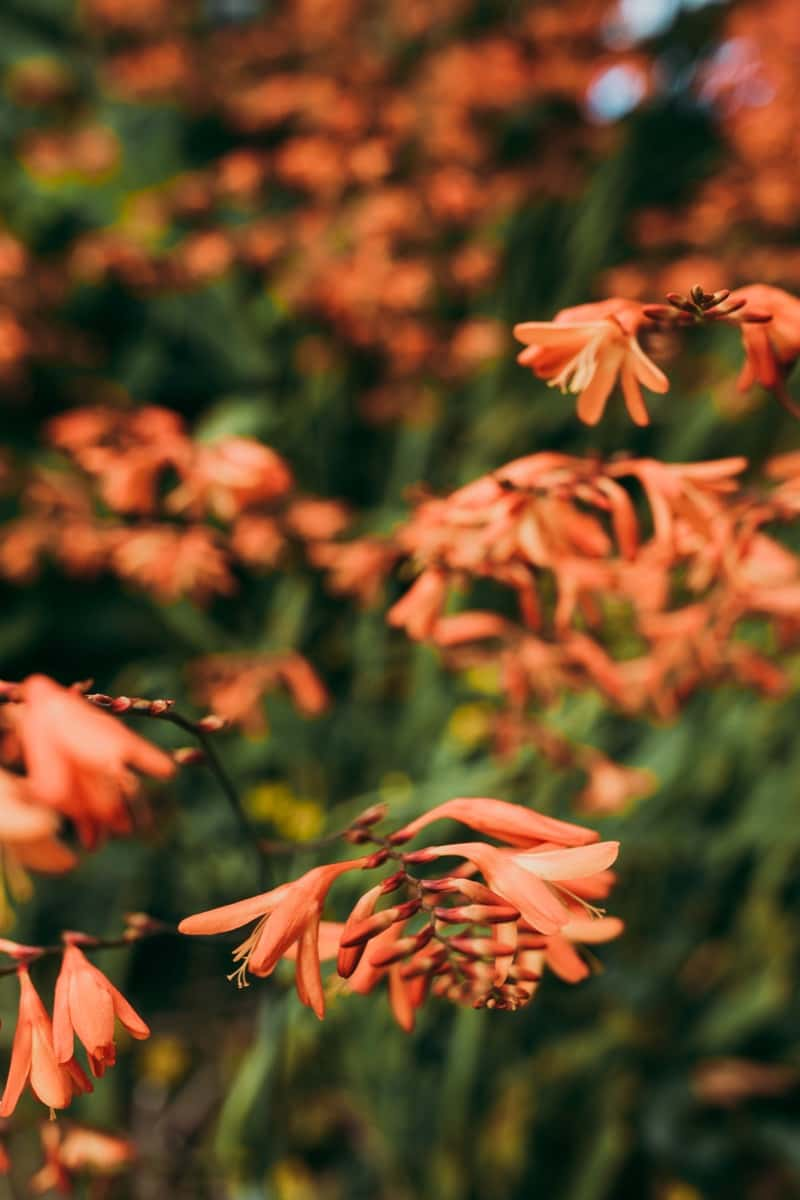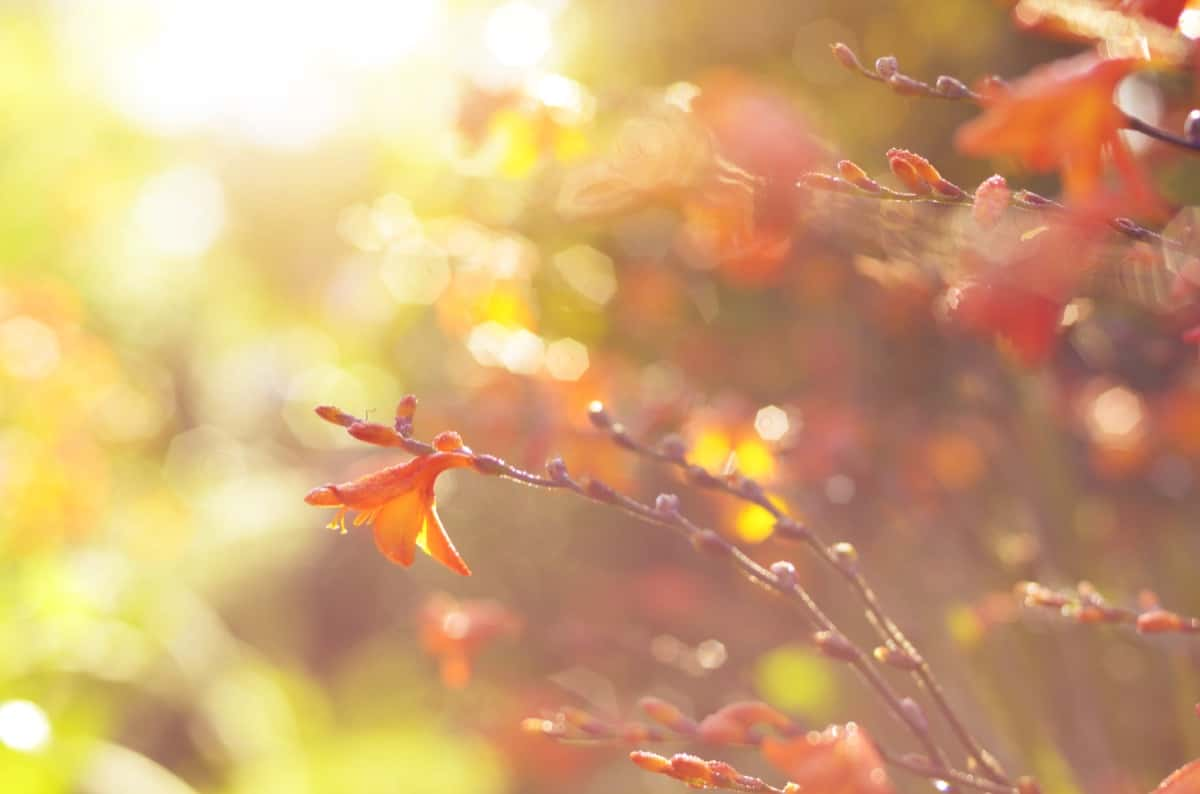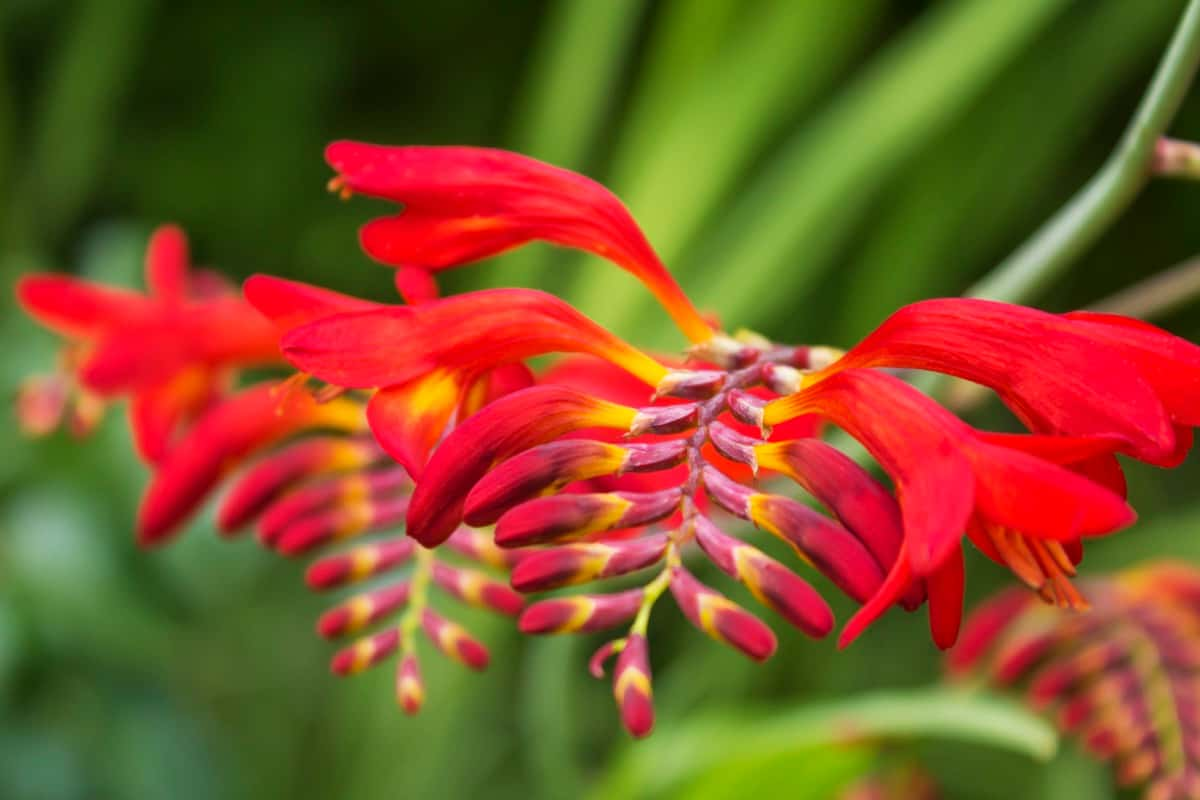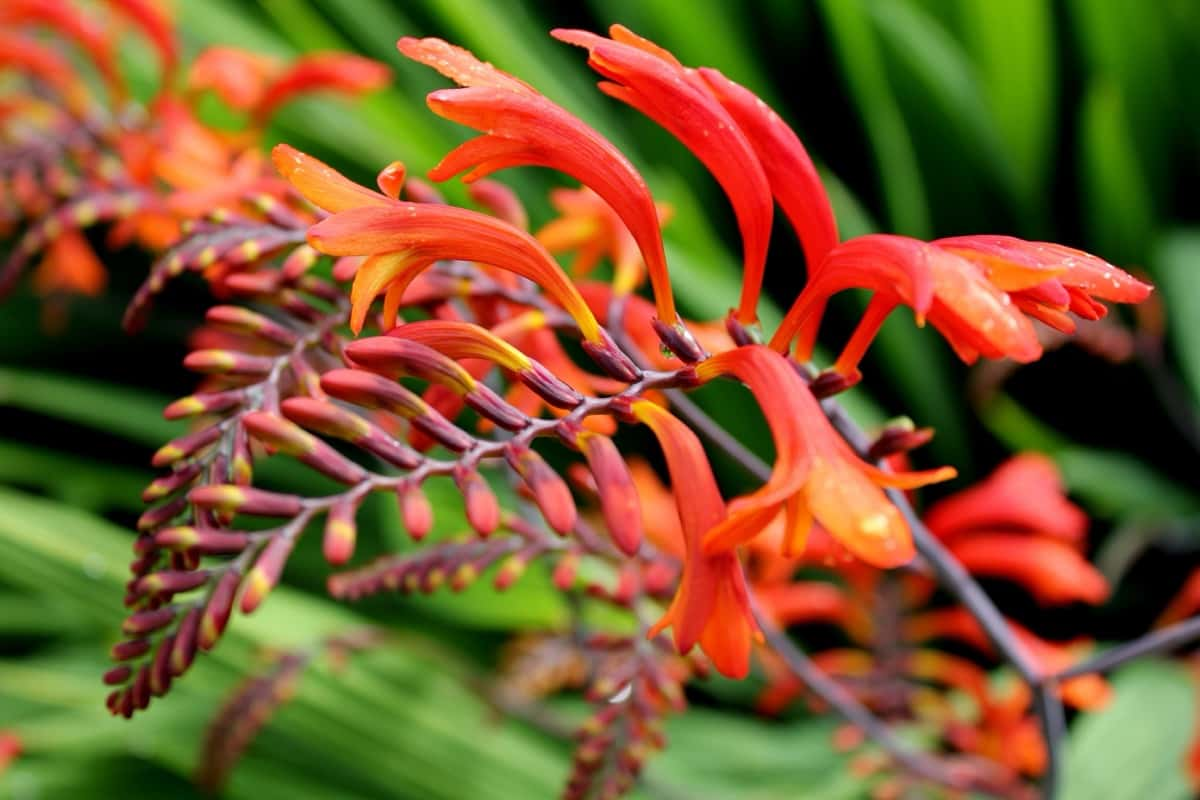Growing and caring for Crocosmia flowers can bring beauty and vibrancy to any garden or landscape. With their elegant arching stems and fiery-hued blooms, these stunning plants will captivate anyone who sees them. Remember to choose the right variety of Crocosmia that suits your preferences and growing conditions.

Providing ideal growing conditions is crucial for the health and vitality of your Crocosmia flowers. From selecting a suitable planting location with well-draining soil to ensuring they receive sufficient sunlight, water, and nutrients throughout their growth cycle, paying attention to these factors will contribute greatly to their overall success.
| Name | Crocosmia flowers |
| Common Names | Coppertips, falling stars, montbretia |
| Plant Type | Perennial |
| Soil pH | Slightly acidic to neutral soils, 6-7 |
| Bloom Time | Summer |
| Sun Exposure | Full, partial |
| Mature Size | 2 feet high, 1-2 feet wide |
How to Grow and Care for Crocosmia Flowers
Planting Crocosmia Bulbs: The Right Way to Grow Beautiful Flowers
If you want to add vibrant color and elegance to your garden, look no further than Crocosmia flowers. These stunning blooms will catch the eye with their fiery hues and graceful arching stems. Choose a place which gets sufficient sunlight throughout the day. Crocosmia thrives in full sun or light shade, so pick a spot that meets these requirements. Once you’ve found the perfect spot, it’s time to prepare the soil. Loosening the soil with a garden tiller to ensure good drainage.
In case you missed it: How to Grow Ranunculus (Buttercup): Propagation, Planting and Care

Crocosmia prefers well-draining soil but can tolerate various types if it doesn’t stay overly wet. If your soil is heavy clay, consider incorporating organic matter. Now, onto planting depth – aim for around 4-6 inches deep when placing your Crocosmia bulbs into the ground. This will provide them enough stability while allowing room for root development and future growth. When watering Crocosmia flowers, they prefer evenly moist soil during active growth but don’t appreciate sitting in soggy conditions.
Preparing the Soil for Crocosmia: Tips for Ideal Growing Conditions
It is essential to choose a well-draining location for planting your Crocosmia bulbs. These plants prefer moist but not waterlogged soil, so avoid areas that tend to retain excessive moisture. Mixing organic matter into the soil can help improve drainage while providing essential nutrients. Before planting, testing your soil pH levels is a good idea. Crocosmia prefers slightly acidic to neutral soils with a pH range of 6.0 to 7.0.
Loosen the soil with a garden tiller before planting to ensure proper root development and prevent compaction. Remove any weeds or grass from the area, as they can compete with Crocosmia for nutrients and water. To promote healthy growth, consider adding slow-release fertilizer specifically formulated for flowering bulbs during the initial planting stage. This will provide essential nutrients gradually over time without causing burn or excessive foliage growth.
Choosing the Right Variety of Crocosmia for Your Garden
Choosing the right variety of Crocosmia for your garden is an exciting task that allows you to showcase your style and preferences. With so many options available, making a decision can be overwhelming. Think about the color palette you want to achieve in your garden. Crocosmia flowers come in various shades, including vibrant oranges, reds, yellows, and bi-color combinations.
Consider the height and size of different Crocosmia varieties. Some varieties are taller and more upright, while others have shorter stems that work well as border plants or in containers. Pay attention to the bloom time of different Crocosmias. Some Crocosmia flowers bloom earlier in summer, while others peak later on.
Crocosmia Planting Depth: How Deep to Plant Bulbs for Optimal Growth
When planting Crocosmia bulbs, the depth is crucial for optimal growth and blooming. These vibrant flowers thrive when planted at the correct depth, allowing their roots to establish in the soil while still receiving enough moisture. Dig a hole approximately three times deeper than the height of your bulb. This will provide ample space for root development without burying them too deeply.
Watering Crocosmia: How Much Water Do These Flowers Need?
Proper watering is key for the healthy growth and vibrant blooms of Crocosmia flowers. When watering Crocosmia, it’s important to strike a balance. Overwatering causes root rot and other issues while underwatering can stunt growth and result in lackluster blooms. Consider factors like temperature and soil conditions to determine the right amount of water for your Crocosmia plants. During periods of drought, you should increase watering frequency.
In case you missed it: How to Grow Trillium Flowers: A Step-by-Step Guide for Planting to Care

Sunlight Requirements for Crocosmia: How Much Sun Exposure Do They Need?
These vibrant beauties thrive in full sun, meaning they need at least six hours of direct sunlight daily. This ensures that they receive enough light energy for photosynthesis, allowing them to produce ample food and nutrients. When choosing a spot for your Crocosmia plants, ensure they get sufficient sunlight throughout the day.
Avoid planting them in shady areas or under trees that might block the sun’s rays. Providing some afternoon shade can be beneficial if you live in an area with intense summer heat. This helps prevent the flowers from wilting or getting scorched by excessive heat. However, don’t overdo it – too much shade can inhibit their growth and flowering.
In regions with extremely hot climates, morning sun combined with dappled shade during the hottest part of the day may be ideal. This allows the plants to soak up sufficient sunlight while offering protection from scorching temperatures. It’s important to note that even though Crocosmia prefers full sun conditions, they can tolerate partial shade as long as they still get a significant amount of direct sunlight each day.
Fertilizing Crocosmia: The Best Fertilizers for Healthy Growth and Blooms
Organic fertilizers are an excellent choice for feeding Crocosmia plants. Composted manure or worm castings can enrich the soil with essential nutrients while improving its structure. Another organic option is fish emulsion, which provides a balanced nutrient mix that promotes strong growth and abundant flowering.
If you prefer synthetic fertilizers, look for a slow-release formula specifically formulated for flowering bulbs. These fertilizers release nutrients gradually over time, providing a steady supply to support continuous growth and blooming throughout the season. It’s important not to over-fertilize your Crocosmia plants, as this can cause excessive foliage growth. Follow package instructions carefully and avoid applying more fertilizer than recommended.
Pruning Crocosmia: When and How to Cut Back Dead Foliage and Flowers
When it comes to timing, it’s best to wait until late fall or early winter to prune your Crocosmia. By this point, the plant has finished flowering and is entering its dormant phase. You’ll want to remove spent flower stalks and yellowed or withered leaves. Simply snip them off at their base using clean pruning shears.
It’s important not to cut back too much foliage, which can weaken the plant. Remove a few inches of green foliage so photosynthesis can still occur. This will help replenish energy reserves in the bulbs for next year’s blooms. As for the cutting technique, use sharp pruning shears to ensure clean cuts without crushing or tearing the plant tissue. Sterilize your tools before use by wiping them down with rubbing alcohol.
Division and Propagation of Crocosmia: How to Multiply Your Plants
Division and propagation of Crocosmia is an excellent way to expand your plant collection and create more beautiful blooms in your garden. This process involves separating the bulbs or corms of established plants and replanting them to form new, independent plants. Choose a mature Crocosmia plant with healthy foliage and robust growth. Dig up the clump using a garden fork or shovel, careful not to damage the bulbs. Once removed from the ground, gently separate the individual bulbs by carefully pulling them apart or using a sharp knife.
In case you missed it: How to Grow Tangelos in the Backyard: Varieties, Planting, Propagation, Pollination, Care, and Yield

Next, prepare the planting area by loosening the soil and adding organic matter. This will provide nutrients for the new plants as they establish themselves. Plant each divided bulb at a depth of around 4-6 inches, spacing them about 8-12 inches apart. Water thoroughly after planting to ensure good soil contact around the roots. Keep the newly divided Crocosmia moist but not waterlogged during their initial establishment period, typically for several weeks after dividing.
Pest and Disease Control for Crocosmia: Common Issues and Solutions
One common pest that can affect Crocosmia is aphids. These tiny insects feed on the sap, causing stunted growth and distorted leaves. To control aphids, spray the plants with water and dish soap as a natural pesticide. Another pesky critter to watch out for is the red spider mite. These pests suck the juices, leaving yellowed or speckled leaves behind.
Regularly check your Crocosmia plants for any signs of infestation and control them with insecticidal soap or horticultural oil if necessary. Fungal diseases can also be problematic for Crocosmia. Ensure good air circulation around your plants by spacing them properly and promptly removing dead or infected foliage. Fungicides specifically designed for these ailments can be used as a preventative measure.
Companion Planting with Crocosmia: Which Plants Grow Well Together
Regarding companion planting with Crocosmia, there are a few key considerations to remember. These vibrant flowers can add color and interest to any garden bed or container, but choosing the right plants to pair them with can make them shine. One option for companion planting with Crocosmia is pairing them with bold and showy flowers. Think big, bright blooms like Dahlias or Hibiscus. The combination of these striking flowers will create a stunning visual display that is sure to turn heads.
In case you missed it: Calandiva Plant Care: Pruning, Propagation, and Indoor Care

If you want a subtler approach, pair Crocosmia with delicate foliage plants like Ferns or ornamental grasses. Their soft textures provide an interesting contrast against the upright growth habit of the Crocosmia, creating a visually pleasing composition. For those who prefer a more functional garden design, consider planting Crocosmia alongside herbs such as Lavender or Rosemary. Not only do these herbs offer aromatic benefits and culinary uses, but they also attract beneficial insects to your garden.
Crocosmia Flowers in Containers: How to Grow These Beautiful Bulbs in Pots
Crocosmia flowers thrive in garden beds and make a stunning addition to containers and pots. Growing Crocosmia bulbs in containers is a great way to enjoy their vibrant blooms up close on your patio, balcony, or porch. To start growing Crocosmia in pots, choose a container that provides enough space for the bulbs to grow and allows good drainage. A pot with a diameter of at least 12 inches is recommended.
Plant the Crocosmia bulbs about 4-6 inches apart in the potting mix. Water thoroughly after planting, and place your container in an area with full sun or partial shade for at least six hours daily. Crocosmia plants love sunlight but can tolerate some shade as well. Water regularly, keeping the soil evenly moist. Check moisture levels by sticking your finger into the soil; if it dries an inch below the surface, it’s time to water again.
During growth and blooming periods, fertilize with a balanced liquid fertilizer every four weeks according to package instructions. This will provide essential nutrients for healthy flower production. As Crocosmia plants grow taller and produce flowers, you may need to support them with stakes or trellises to prevent drooping or bending.
In case you missed it: Pinstripe Plant Care: Best Fertilizer, Pruning, and Propagation

Conclusion
Crocosmia flowers are beautiful additions to any garden or home decor and are relatively easy to cultivate. You can ensure their healthy growth and vibrant blooms by providing them with well-draining soil, ample sunlight, and regular watering. With patience and care, you’ll be rewarded with clusters of vivid orange, red, or yellow flowers that will brighten up your surroundings. Whether arranging them in bouquets or adding pops of color to floral arrangements around your home, these versatile beauties will add a touch of elegance wherever they go.
- Broccoli Seed Germination and Selection
- Asparagus Seed Germination and Variety Selection
- Seasonal Flower Gardening: Best Practices for Spring, Summer, Fall, and Winter
- How to Grow Hibiscus from Flower
- Plantation Ideas for Home Decoration: A Beginners Guide
- Flower Garden Designs and Layouts for Beginners
- Planting and Spacing Techniques in Papaya: A Beginner’s Guide
- Growing Gold: Essential Techniques for Planting Pineapples
- How to Make Kalanchoe Plant Bushy: Home Remedies and Solutions
- 11 Reasons Why Your Gardenia is Not Blooming: Home Remedies and Solutions
- Eco Elegance: The Guide to Designing a Drought-Tolerant Landscape
- Gardening on a Slope: Strategies for Hillside Landscaping
- Nourish and Flourish: Top Organic Mulches for Thriving House Plants
- Everything You Want to Know about Indian Mogra Flower: Discover Uses and Growing
- Green Thumb Success: Expert Tips for Cultivating Greenhouse Pumpkins All Year Round
- Maximize Growth & Flavor: The Ultimate Guide to Companion Planting in Herb Gardens
- How to Control Rhododendron Problems Naturally: Home Remedies and Organic Ways to Fix Them
- Natural Magic: The Remarkable Benefits of Cinnamon for Plants
- Best Steps to Revive Dying Tulip with Natural and Organic Treatment
- 10 Reasons Why Your Angel Trumpet is Not Blooming: Remedies and Treatment
- How to Fix Periwinkle Leaf and Flower-Related Problems: Natural Remedies and Solutions
- How to Fix Zinnias Leaf and Flower Problems: Discover Natural and Home Remedies
- Organic Steps to Induce Lemon Tree Flowers: A Comprehensive Guide
- Bloom Booster: Crafting the Perfect Homemade Bougainvillea Fertilizer
- Optimizing Growth: A Guide to Applying NPK Fertilizer for Potted Plants
- 10 Best Homemade Fertilizers for Rubber Plant: DIY Recipes and Application Method
- How to Boost Female Pumpkin Flowers: Effective Steps for More Flowers and High Yields
- Transform Your Indoor Garden: Top Benefits of Pink Salt for Houseplants
- 10 Best Homemade Fertilizers for Peacock Plants (Calathea): Easy DIY Guide
- Unlock Blooms: 9 Reasons Why Your Potted Chrysanthemum is Not Blooming
- 8 Reasons Why Your Potted Hibiscus is Not Blooming: Fix it with Simple Solutions
- Unlock Blooms: 9 Key Reasons Your Potted Frangipani Won’t Flower
- 10 Reasons Why Is My Ice Plant Not Blooming: Remedies and Treatment
- 10 Reasons Why My Potted Hydrangea Not Blooming: Treatment and Remedies
- 10 Reasons Why is My Wisteria Not Blooming: Remedies and Treatment
- 10 Reasons Why is My Goldfish Plant Not Blooming: Remedies and Treatment